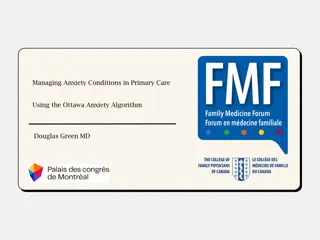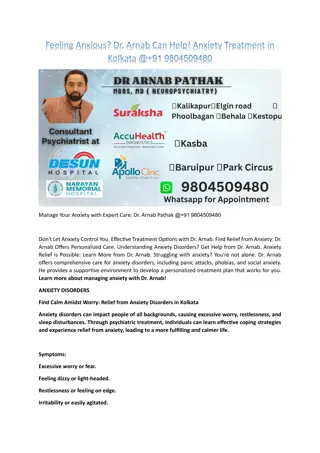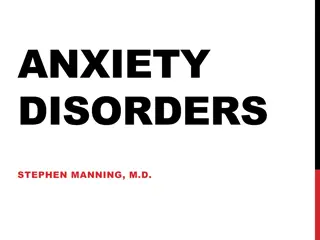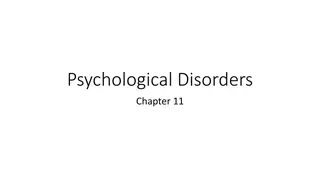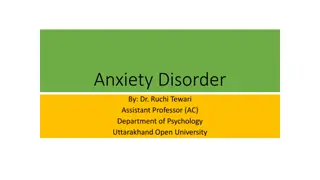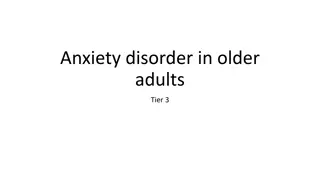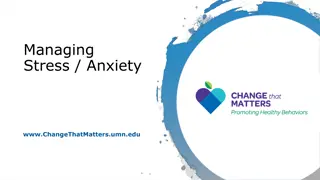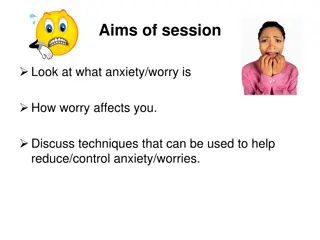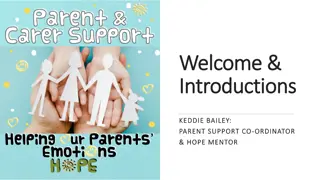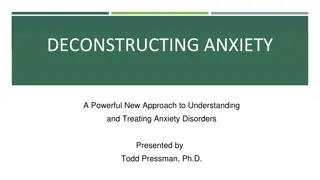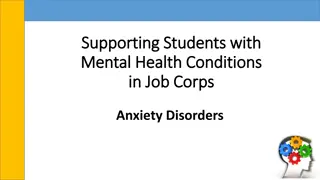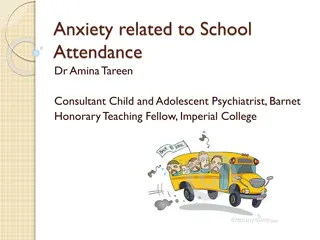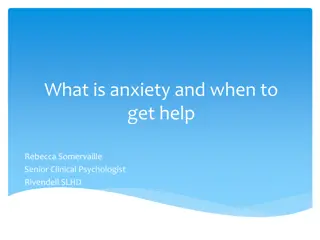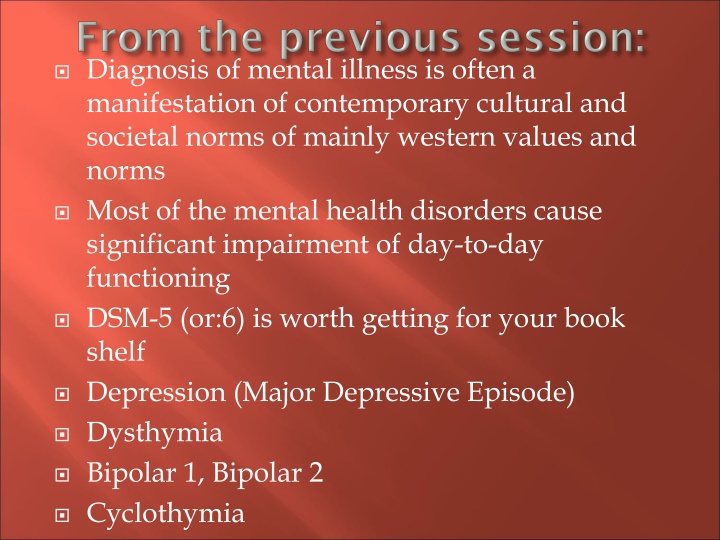
Mental Illness and Anxiety Patterns
Explore the cultural influences on mental illness diagnosis, the impact of anxiety on daily life, and the variations in anxiety symptoms. Learn about specific mental health disorders like depression, bipolar disorder, and phobias, along with coping mechanisms for anxiety.
Download Presentation

Please find below an Image/Link to download the presentation.
The content on the website is provided AS IS for your information and personal use only. It may not be sold, licensed, or shared on other websites without obtaining consent from the author. If you encounter any issues during the download, it is possible that the publisher has removed the file from their server.
You are allowed to download the files provided on this website for personal or commercial use, subject to the condition that they are used lawfully. All files are the property of their respective owners.
The content on the website is provided AS IS for your information and personal use only. It may not be sold, licensed, or shared on other websites without obtaining consent from the author.
E N D
Presentation Transcript
Diagnosis of mental illness is often a manifestation of contemporary cultural and societal norms of mainly western values and norms Most of the mental health disorders cause significant impairment of day-to-day functioning DSM-5 (or:6) is worth getting for your book shelf Depression (Major Depressive Episode) Dysthymia Bipolar 1, Bipolar 2 Cyclothymia
Terapia Postgraduate Certificate in Adult Counselling
Fear is a response to a threat that is known, external, definite, or nonconflictual in origin. Anxiety is in response to threat that is unknown, internal, vague, or conflictual in origin. Fear may also be due to an unconscious, repressed, internal object displaced to another thing in the external world.
Individual patterns of anxiety vary. cardiovascular symptoms (palpitations and sweating), gastrointestinal symptoms (nausea, vomiting, butterflies in stomach , diarrhoea, ) visceral reactions (urinary frequency, shallow breathing, tightness in the chest, ) muscle tensions (headache, wry neck, spasms)
Anxiety usually leads to action designed to remove or reduce a threat. This action may be constructive, in which case a person utilizes coping mechanisms if the action is mainly conscious or deliberate (such as studying for an exam) of defence mechanisms if behaviour is largely determined by unconscious forces.
Separation Anxiety Disorder Selective Mutism Specific Phobia
Specific Phobia clinically significant anxiety provoked by exposure to a specific feared object or situation, often leading to avoidance situation. Social Anxiety Disorder (Social Phobia) Panic Disorder
Panic Attack is not a mental disorder Panic Disorder is (recurrent unexpected panic attacks) (a discrete period in which there is the sudden onset of intense apprehension, fearfulness or terror, often associated with feeling of impending doom. Panic Attack reaches its peak in minutes)
Palpitations, pounding heart, or accelerated heart rate Sweating Trembling or shaking Sensations of shortness of breath or smothering A feeling of choking Chest pain or discomfort Nausea or abdominal distress Feeling dizzy, unsteady, lightheaded, or faint Feelings of unreality (derealization) or being detached from oneself (depersonalization) Fear of losing control or going crazy Fear of dying
Agoraphobia is an anxiety about, or avoidance of, places or situations from which escape might be difficult (or embarrassing) or in which help may not be available in the event of having a panic attack or panic symptom.
In previous versions of DSM, agoraphobia was associated with panic disorder. With the updates of DSM-5, it is now a separate and codable diagnosis. This is one of the biggest differences in the updates. Within the update to agoraphobia, DSM-5 notes that a person must experience intense fear or anxiety in a minimum of two situations. These include being out in public, open spaces, and in crowds, essentially anywhere in which you're outside of the home. It also notes that avoidance behaviours must be exhibited. These are a result of the fear of being in situations that may induce panic attacks or anxiety in which help may not be available or that it's difficult to flee.
Generalised Anxiety Disorder Substance or Medication Induced Anxiety Disorder
Most of known modalities can be helpful Cognitive Behavioural Therapy (CBT) is particularly helpful
Obsessive-Compulsive Disorder obsessions (which cause marked anxiety or distress) and/or compulsions (which serve to neutralize anxiety)
Body Dysmorphic Disorder (with different degree of insight and repetitive behaviours) Hoarding Disorder Trichotillomania Excoriation Disorder
PTSD Acute Stress Disorder Adjustment Disorders Other Specified and Unspecified Trauma and Stressor-Related Disorders
In order to be diagnosed with PTSD according to the DSM-5, you need to meet the following: Criterion A One symptom (or more) from Criterion B One symptom (or more) from Criterion C Three symptoms (or more) from Criterion D Three symptoms (or more) from Criterion E Criteria F through H 1. 2. 3. 4. 5. 6.
Criterion A You were exposed to one or more event(s) that involved death or threatened death, actual or threatened serious injury, or threatened sexual violation. In addition, these events were experienced in one or more of the following ways: You experienced the event You witnessed the event as it occurred to someone else You learned about an event where a close relative or friend experienced an actual or threatened violent or accidental death You experienced repeated exposure to distressing details of an event, such as a police officer repeatedly hearing details about child sexual abuse
Criterion B You experience at least one of the following intrusive symptoms associated with the traumatic event: Unexpected or expected reoccurring, involuntary, and intrusive upsetting memories of the traumatic event Repeated upsetting dreams where the content of the dreams is related to the traumatic event The experience of some type of dissociation (for example, flashbacks) where you feel as though the traumatic event is happening again Strong and persistent distress upon exposure to cues that are either inside or outside of your body that are connected to your traumatic event Strong bodily reactions (for example, increased heart rate) upon exposure to a reminder of the traumatic event
Criterion C Frequent avoidance of reminders associated with the traumatic event, as demonstrated by one of the following: t Criterion C Frequent avoidance of reminders associated with traumatic event as demonstrated by one of the following: 1. Avoidance of thoughts, feelings, or physical sensations that bring up memories of the traumatic event 2. Avoidance of people, places, conversations, activities, objects, or situations that bring up memories of the traumatic event
Criterion D At least three of the following negative changes in thoughts and mood that occurred or worsened following the experience of the traumatic event: The inability to remember an important aspect of the traumatic event Persistent and elevated negative evaluations about yourself, others, or the world (for example, "I am unlovable," or "The world is an evil place") Elevated self-blame or blame of others about the cause or consequence of a traumatic event A negative emotional state (for example, shame, anger, or fear) that is pervasive Loss of interest in activities that you used to enjoy Feeling detached from others The inability to experience positive emotions (for example, happiness, love, joy) 1. 2. 3. 4. 5. 6. 7.
Criterion E At least three of the following changes in arousal that started or worsened following the experience of atraumatic event: Irritability or aggressive behavior Impulsive or self-destructive behaviour Feeling constantly "on guard" or like danger is lurking around every corner (or hypervigilance) Heightened startle response Difficulty concentrating Problems sleeping
Criterion F The above symptoms last for more than one month. Criterion G The symptoms bring about considerable distress and/or interfere greatly with a number of different areas of your life. Criterion H The symptoms are not due to a medical condition or some form of substance use.
In order to be diagnosed with PTSD according to the DSM-5, the client needs to meet the following: Criterion A One symptom (or more) from Criterion B One symptom (or more) from Criterion C Three symptoms (or more) from Criterion D Three symptoms (or more) from Criterion E Criteria F through H 1. 2. 3. 4. 5. 6.
Most of known modalities can be helpful EMDR is particularly helpful in alleviating symptoms, mainly flashback
Acute Stress Disorder Adjustment Disorders

